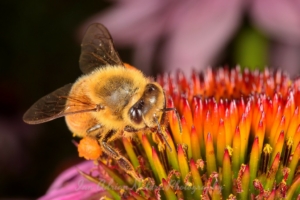By Ian Adrian | February 27, 2019

Image caption
It was nearly 6 years ago and I still lived in Central Pennsylvania. I recall visiting my mother, Andrea, one particular day in late summer. My tranquil childhood home, at which she still resided, was surrounded by tall forest of oak, beech, and pine trees. Strewn in front of the house was approximately 1/4 acre of green grass. Not long before, I had read a snippet addressing the dreadful impact of non-native grass yards. Like any other child of the digital age, I found myself following the proverbial rabbit deep into his hole. What I encountered was alarming!
According to a NASA-sponsored study in 2005, lawns cover approximately 50,000 square miles of land across the US. This translates to nearly 9 billion gallons of water being used every single day for outdoor landscaping, much of that landscaping being our lush lawns. Yikes! I was blown away! Reading further, I learned that, not only do most grass yards replace native plants, but they encourage the use of such obscenely destructive products as Roundup which, not unlike other herbicides, kills an appalling number of bees and butterflies, upon whom we’re reliant for food production. I felt overwhelmed and a bit disgusted by the enormity of this problem. Rather than wallow in misery, however I decided to do my tiny part in curbing this issue.
The yard was not huge by regional standards. No herbicides had ever been dumped upon it, and very little water had been wasted in maintenance, but I could not escape the feeling that the fertile earth might serve a better purpose. After thoroughly exploring the situation with Andrea, she eagerly agreed that a large portion of yard should be converted into a wildflower meadow! With autumn right around the corner and all the associated challenges of frozen earth, the clock was ticking. Following just enough research to grasp the basics of creating a wildflower meadow, I dove in!
The first step was to tear out the existing grass. Snagging a roto-tiller at the nearby equipment rental, I went to town. This self-propelling machine was easy to operate and actually kind of fun! Only a couple passes were required in order to tear out the existing monoculture, leaving only lumps of grass and bare earth. We collected the lumps and covered the entire area in tarps, wood, and anything else we could find with the intent of suffocating any remaining grass seeds. I later realized this last step had been a poor decision which ultimately insulated and protected unwanted seeds already embedded. Oops!
As winter yielded to spring and temperatures remained above freezing, the tarps were removed and seeds were planted. I scattered an assortment of flowers including cosmos, partridge pea, common and butterfly milkweed, coneflowers, bee balm, pasture thistle, and black-eyed susans. Straw, donated by a neighboring farmer sympathetic to our project was then spread across the ground to protect the seeds and hide them from overzealous birds. The annuals soon began to emerge. We were both ecstatic! A bit thin the first year, they still provided gorgeous ground cover in an array of colors! Grass also began to re-emerge in spots, likely exacerbated by the tarps. Removing what we could, it was now up to the wildflowers to claim their land! Flowers continued to flourish through the summer, eventually dying off as cold weather assaulted the area.
Wildflower season #2 was pure joy! The annuals came in much thicker, offering even more colors to enhance our micro-meadow and the perennials (for which I was most excited) contributed their displays. The isolated grassy patches were all but gone. Enticed by aromas boasting nectar and pollen, a host of different butterflies and bees now graced the meadow. As the susans and coneflowers turned to seed, birds became more abundant. Goldfinches, in particular, loved to perch atop these natural buffets.
The following year brought even more color. Butterflies and bees were downright abundant! The meadow was now thick with color from spring, through the end of summer and even early autumn. All manner of tiny creatures such as vibrant leafhoppers and tiny jumping spiders lived throughout this lush little sea of green. Hummingbird moths darted amidst the bee balm and actual hummingbirds made frequent appearances. Despite all the joy, however, a new challenge had emerged….Japanese stiltgrass was quickly encroaching!
The two consecutive years were thick with welcome plants and creatures in addition to a plague of stiltgrass. Plucking the reachable invaders (before they go to seed), however, appears to be enough assistance. Although some stiltgrass has prevailed through year 6, the tall perennials seem to largely outcompete this invasive plant throughout much of the meadow. Bird and pollinator life is now abundant and I feel a growing sense of joy and pride every upon every return visit! For under $100, you can add beauty and protect our planet at the same time!





Facebook Comments